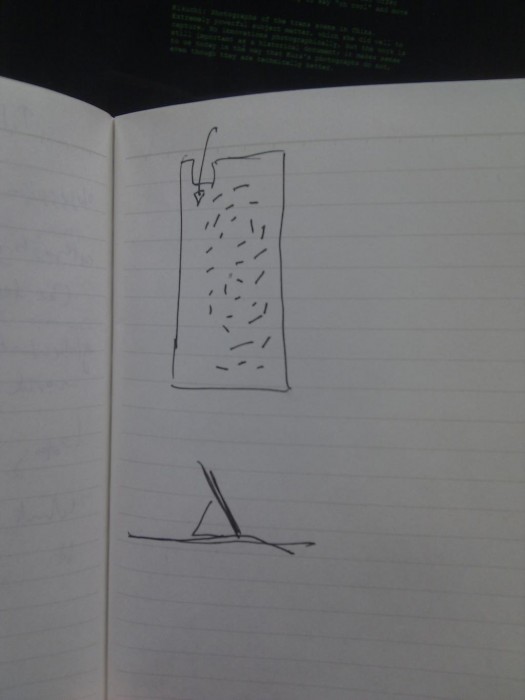
Rasen Kaigan
Brilliant installation, which destroys any illusion that you are “inside” a photograph, or looking “through” it, as a window. “Rasen Kaigan” does not have a starting point, but when you walk into the space, you are immediately aware that you are looking at three-dimensional objects.
Shiga made some excellent land art along the way here. This could have stood on its own as a separate work.
Complicated thoughts, text, layout.
#8s – Rock photos.
You can’t see any images when you walk in; you are greeted by the backs of the photos.
Gaze of #1 bounces off #2, then is reflected (scattered?) in sea of #8s.
Hard/impossible to look *directly* at #1 because it is physically blocked by #2.
#9s – “monsters” – pitch black “photos” which actually function like mirrors. Andrew is disappointed in the printing quality, says they’re not really black.
#6 seems like they represent photos taken before 3/11. Not always easy to tell what’s before or after though. This is to its credit.
*Really* ambitious text.
<coffee break out on the street>
Strange effect where foreground looks like it’s shot from above, but background is straight on.
Why a spiral? Beach photo, etc.
Husband leading wife through purple pond.
<notes added later>
Nothing particularly “Japanese” about these photographs–not even any representation of Japanese characters, and no writing at all.
When you enter the exhibit, you are greeted by the backs of photographs. From the start, you are aware that you are looking at three dimensional objects, not magical “windows.”
After this show, it’s difficult to look at photos hung on the wall in the “normal” way.
What will the book look like?
The show is not perfect: the “map” and accompanying texts are sometimes better left ignored—perhaps, especially, at first. Shiga’s ideas are convoluted, or labyrinthine, which is after all fitting given the title of the show. The spiral is the central motif of the installation, and the images themselves.
Andrew notes that Shiga was not satisfied with Canary; she pushed herself when she could have made 10 more books in that vein and solidified a place for herself. What drove her to push on?
She has taken on the role of an organizer. She is working directly with her subjects, and they all know what she is doing—no stealth here, no snapshots. But it’s not performance-based, either. Remember Nietzsche: artist makes art out of life. Her work has an organizing function in that she is bringing people together. Author as producer, Tretiakov etc.
She could have made a series just of her land art photographs and called that a series. The same goes for some of the other threads running through this work.
Very rare to feel that one is experiencing a work of genius, which demands hours (if not days) of attention.
In musical terms, prog-photo, a triple album of photography, flawed but brilliant.
<notes I’m adding now>
This show is not perfect, but that’s not really a productive way to evaluate it. By aiming this high, Shiga has raised the bar for what a photography exhibit can be. I have continued to use the prog-rock image in describing this exhibit to other people, as a way to illustrate not just the ambition but intensity of her project.
Minoru Shimizu has written a harsh review (in Japanese) of the show 1 in which he calls it “B-grade horror”; I’m working my way through this text.